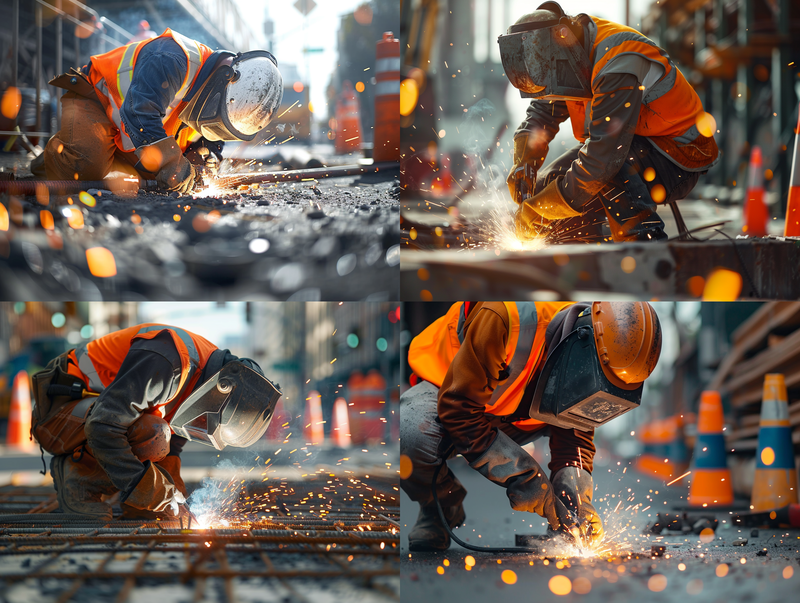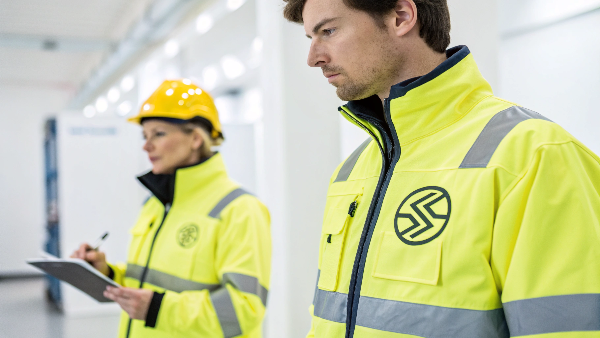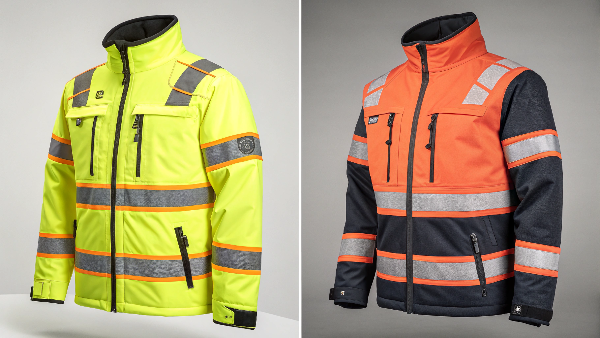Imagine you’re driving down a busy highway, and suddenly, you notice a construction zone ahead. The workers are diligently performing their tasks, but something catches your eye – they’re all wearing bright orange vests. You might wonder why orange? Just as you ponder this, a moment of realization hits you. The workers’ visibility is crucial not only for their safety but also for yours. Without these vivid, high-visibility garments, the risk of accidents would skyrocket. This article dives deep into why orange is the color of choice for construction workers and the critical role it plays in ensuring safety on construction sites.

Why Do Construction Workers Wear Orange?
Construction workers wear orange high-visibility clothing for several essential reasons:
Safety
Safety is the paramount reason for donning orange high-visibility clothing. On construction sites, workers face numerous hazards, from heavy machinery to speeding vehicles. The bright orange color is highly visible, even in low-light conditions, ensuring that workers can be easily seen by drivers, machine operators, and fellow workers. This heightened visibility significantly reduces the risk of accidents and injuries, making construction sites safer for everyone involved.
Visibility
Orange is a color that stands out against most backgrounds, making it an excellent choice for high-visibility clothing. Whether it’s a foggy morning, a rainy afternoon, or a bustling construction site, orange ensures that workers remain visible from a distance. This visibility is crucial for preventing accidents, as it allows drivers and machine operators to spot workers well in advance, giving them ample time to react and avoid potential collisions.
Legal Requirements
In the United States, the Occupational Safety and Health Administration (OSHA) mandates the use of high-visibility clothing for certain construction workers. For example, flaggers and workers exposed to public vehicular traffic near excavations are required to wear high-visibility garments. Compliance with these regulations not only ensures worker safety but also helps companies avoid costly fines and legal issues.
Industry Standards
High-visibility clothing is a standard practice in the construction industry. Orange is a common color used for this purpose, ensuring consistency and safety across job sites. Regardless of the specific job site or work conditions, the use of orange high-visibility clothing ensures that workers are easily identifiable and protected from potential hazards.
Bridging the Gap
Understanding the importance of high-visibility clothing in construction is just the beginning. To truly appreciate why orange is the color of choice, it’s essential to delve deeper into its significance and the broader context of color codes in the construction industry. Let’s explore the meaning of the color orange in construction and how it fits into the larger framework of color codes and safety standards.
What Does the Color Orange Mean in Construction?
In the construction industry, the color orange is synonymous with safety and caution. Its high visibility makes it an effective tool for conveying warning messages to both drivers and workers. Orange is used in various applications within the construction sector, including:
Safety Gear: High-visibility vests, jackets, and helmets in orange ensure that workers are easily seen by others on the job site.
Signage: Orange signs are often used to indicate construction zones, road work, and other areas where caution is required.
Barriers and Cones: Orange barriers and traffic cones are used to guide traffic and protect workers from vehicular hazards.
The use of orange in these contexts helps to prevent accidents and ensures that everyone on the site is aware of potential dangers.
What Color Do Construction Workers Wear?
While orange is the most common color for high-visibility clothing in construction, it’s not the only option. Construction workers may also wear other high-visibility colors, such as:
Yellow: High-visibility yellow is another popular choice for safety gear. It offers similar visibility benefits as orange and is often used interchangeably.
Green: High-visibility green is less common but still used in some construction settings. It can provide excellent visibility in certain environments.
The choice of color often depends on the specific job site and the surrounding environment. However, orange remains the most widely recognized and utilized color for construction safety gear.
What Are Color Codes in Construction?
Color codes play a crucial role in the construction industry, providing a standardized method of conveying important safety and warning messages. These codes ensure consistency and clarity in communication, helping to prevent accidents and promote a safer work environment. Here are some key color codes used in construction:
Red: Red is used to indicate immediate danger and is often associated with fire protection equipment, emergency stop buttons, and hazardous areas.
Yellow: Yellow signifies caution and is commonly used for warning signs, caution tape, and areas where there are potential hazards.
Blue: Blue is used to convey information and is often associated with mandatory instructions, such as “Wear Protective Equipment.”
Green: Green indicates safety and is used for first aid stations, safety equipment, and safe areas.
Orange: Orange is used for warning and caution, particularly in construction zones and areas with heavy machinery or vehicular traffic.
These color codes help to create a standardized approach to safety, ensuring that workers and visitors can quickly and easily understand the potential risks and necessary precautions on a job site.
What Are the Basic Colors for Construction?
Beyond safety gear and signage, colors play a significant role in construction branding and logo design. The basic colors used in construction branding include:
Blue: Blue conveys credibility, reliability, and trust. It’s often associated with professionalism and stability, making it a popular choice for construction company logos and branding materials.
Green: Green symbolizes growth, nature, and abundance. It can be used to communicate eco-friendly practices and sustainable construction, appealing to clients who prioritize environmental responsibility.
Red: Red represents energy, passion, and excitement. It can be used to convey a sense of urgency or importance, making it an effective color for branding materials that aim to grab attention and inspire action.
These colors help construction companies establish their brand identity and communicate their values to clients and stakeholders.
Why Is Orange a Warning Color?
Orange is considered a warning color because of its high visibility and attention-grabbing properties. It stands out against most backgrounds, making it an effective choice for conveying caution, alertness, and hazard awareness. The use of orange as a warning color is deeply ingrained in various industries, including construction, road work, and emergency services. Here’s why orange is so effective:
Visibility: Orange is a bright and highly visible color that can be easily spotted from a distance, even in low-light conditions. This makes it ideal for safety gear and signage.
Attention-Grabbing: The vibrant hue of orange naturally draws attention, ensuring that warning signs and safety gear are noticed by workers and the public.
Association with Hazard: Over time, orange has become universally associated with caution and hazard awareness. This association reinforces the importance of paying attention to orange signs and gear.
The use of orange as a warning color helps to enhance visibility and draw attention to potential dangers, ultimately promoting a safer work environment.
Is Orange a Caution or Warning?
Orange is used as both a caution and warning color in construction and safety signage, but with some key differences:
Orange as a Warning Color
Temporary Hazards: Orange warning signs are often used to highlight temporary hazards or indicate the presence of construction and maintenance activities.
ANSI Standards: The American National Standards Institute (ANSI) specifies that warning signs have “WARNING” written in black on an orange background, often accompanied by additional safety symbols or text.
Significant Hazards: Orange warning signs alert workers and the public to significant hazards that could cause serious injury or death. Examples include “Warning: Construction Zone,” “Warning: High Voltage Equipment,” and “Warning: Flammable Materials.”
Orange as a Caution Color
General Caution: While orange is primarily used for warning, it can also serve as a general caution color in some contexts. For example, orange cones and barriers are used to guide traffic and indicate areas where caution is required.
Non-Emergency Situations: In non-emergency situations, orange can be used to signal the need for heightened awareness and careful attention to surroundings.
The dual use of orange as both a caution and warning color underscores its versatility and effectiveness in promoting safety and hazard awareness.
Conclusion
In the world of construction, safety is paramount, and high-visibility clothing plays a crucial role in ensuring the well-being of workers. The color orange, with its high visibility and attention-grabbing properties, is the perfect choice for safety gear, helping to prevent accidents and promote a safer work environment. From its use in safety gear and signage to its role in conveying warning and caution messages, orange is an indispensable color in the construction industry.
Understanding the significance of orange and the broader context of color codes in construction helps to appreciate the meticulous planning and attention to detail that goes into creating a safe and efficient work environment. By adhering to these standards and prioritizing safety, construction companies can protect their workers, comply with regulations, and ultimately contribute to a safer and more productive industry.



